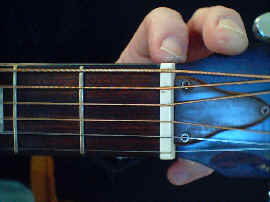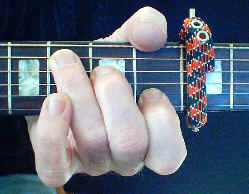
guitar capo
The capo is a device that is attached to the
fretboard and over each string. Using a capo allows you to play the standard open position chords at any fret you like.
Why would you want to play these chords in a different position of the guitar fretboard? One reason is to change the key
of the song and use the same guitar chords you would as in the open position. Another reason would be to change the key
of the song to match the key to your vocals. Another reason to use a capo is to just change the sound.
I've learned that when I place a capo on my guitar, the quality of the sound really improves. The notes ring clearer and
more defined. This may be because my acoustic guitar is not the greatest of guitars.
What I would like to do is give you a few examples of how you could go about changing the chords to a song with a capo.
And at the same time explain a little about progressions. By learning to play just the basic 1-4-5 progression, you can
begin to write your own songs. Since the lessons on Guitar Secrets covers the key of C major and modes, I will explain
the capo using the key of C major.
In the key of C major the notes and chords are C Dm Em F G Am B dim. The 1- 4-5 progression in the key of C major would
be C F and G. The tablature for each of these chords have been illustrated below.
C chord F chord G chord
-0---------------1---------------3------
-1---------------1---------------0--------
-0---------------2---------------0--------
-2---------------3---------------0--------
-3--------------------------------2-------
-----------------------------------3------
The guitar has a few pieces of hardware you should be familiar with. The guitar has the
body, neck, bridge, saddle, tuners and most an adjustment rod.
The part that we're concerned with is the nut. The nut is the plastic or bone piece in which the strings are guided
through. It is located next to the first fret and has small slots where each string rests in.

Nut
||--------|--------|----------
||--------|--------|----------
||--------|--------|---------
||--------|--------|---------
||--------|--------|---------
||--------|--------|---------
1st 2nd 3rd frets

3rd
4th 5th 6th
||------|------|-----+|----0-|------|-------|-------|
||------|------|-----+|----1-|------|-------|-------|
||------|------|-----+|----0-|------|-------|-------|
||------|------|-----+|-------|--2--|-------|-------|
||------|------|-----+|-------|------|----3-|-------|
||------|------|-----+|-------|------|-------|-------|
3rd fret
has capo + over strings
Now of course, even though you're playing the
chords C F and G they are no longer really considered the C F and G chords. This is because we are now playing them 3
frets higher than the normal open position. Remember when we use the capo, we are actually changing the key and chord
names.
Since we are raising the pitch by 3 frets, we are actually raising the notes by 3 half steps. A half step is equal to 1
fret on the guitar. So if we raise the key of C major by 3 half steps, we would have the key of Eb. This is want it
would look like if we raised the C note up say 3 half steps. C Db D Eb or the same thing using sharps would be C C# D
D#. D# and Eb are the same notes. So we will use the key of Eb.
The notes in the key of Eb are: Eb Fm Gm Ab Bb Cm D dim.
The notes in the key of C are: C Dm Em F G
Am Bdim
So when you play the C chord with the capo at the 3rd fret, the C would equal the Eb, F would be Ab and G would be Bb.
Figuring out what key is the tricky part. But using the capo can be a lot of fun and lead to tons of new ideas.
The progression pattern below is one of the
most used patterns to write songs. Strum each one time as indicated below. Put some words to it and you will have a
song. We will work more on this in the future.
Strum in this pattern:
C C C C F F F F
C C C C G G G G
C C C C F F F F
C C G G C C C C
F F F F C C C C
F F F F C C C C
F F F F C C C C
G G G7G7 C C C C
G7
--1----
--0----
--0----
--0----
--2----
--3----
Good Luck
From the Jam Room